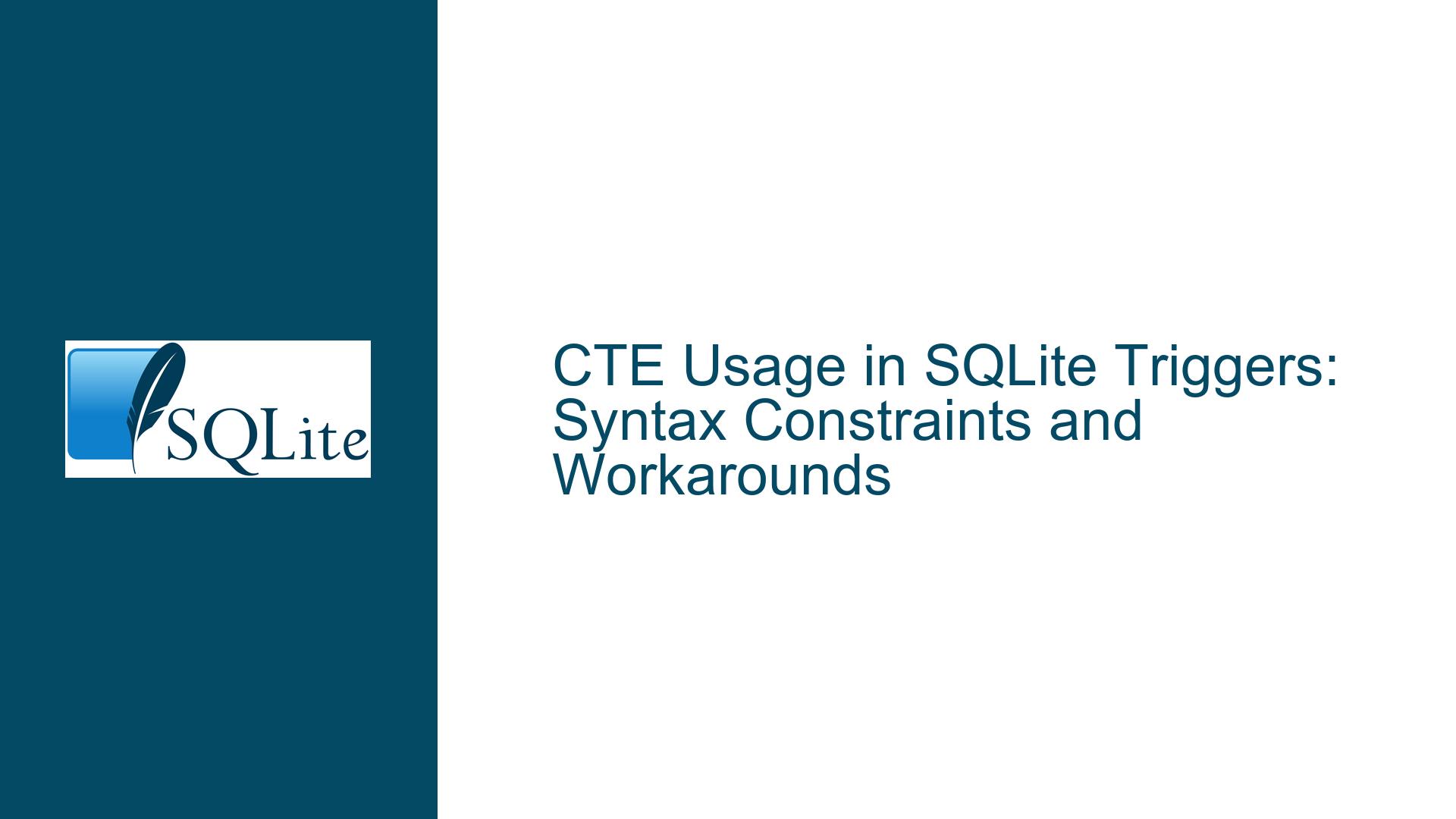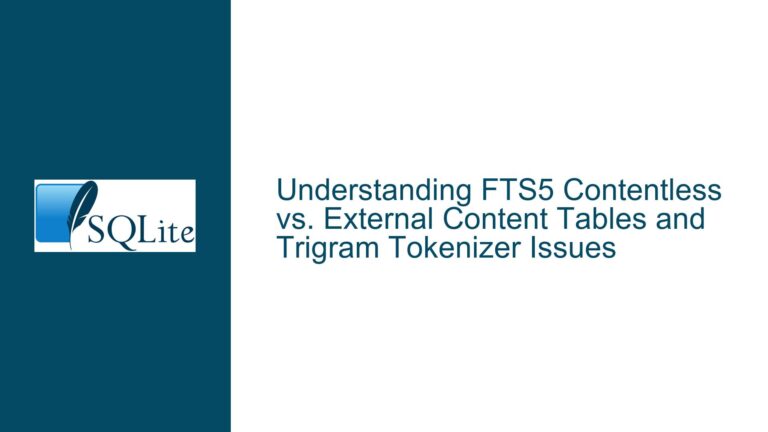CTE Usage in SQLite Triggers: Syntax Constraints and Workarounds
CTE Syntax Restrictions in SQLite Trigger Statements
The core issue revolves around the use of Common Table Expressions (CTEs) within SQLite triggers. The official SQLite documentation explicitly states that CTEs are "not supported" in trigger statements. However, users have discovered scenarios where nested CTEs within subqueries or SELECT expressions inside triggers do execute without errors. This discrepancy between documented limitations and observed behavior has led to confusion about the scope of CTE restrictions and their implications.
Key Observations from the Discussion
Documentation vs. Reality: The documentation prohibits CTEs in triggers, but nested CTEs (e.g., within a
SELECTclause of anINSERTstatement) often work. For example:CREATE TRIGGER copy_content INSERT ON src BEGIN INSERT INTO dst SELECT ( WITH loophole AS (SELECT new.content) SELECT * FROM loophole ); END;This trigger compiles and runs despite the CTE being present. However, top-level CTEs (e.g.,
WITH ... INSERT) in triggers result in syntax errors.Parser Limitations: The SQLite parser restricts CTEs at the top level of trigger statements but does not enforce this restriction recursively in subqueries. This creates an inconsistency where CTEs are partially usable but not officially endorsed.
Semantic Ambiguity: The term "not supported" is misinterpreted as "syntactically invalid." In reality, it indicates that CTEs in triggers are not guaranteed to work reliably across SQLite versions or edge cases. Users might encounter silent failures or unexpected behavior in the future.
Why This Matters
Triggers are critical for enforcing data integrity and automating workflows. CTEs simplify complex queries by breaking them into modular components, which is especially useful for multi-step data transformations. The inability to use CTEs in triggers forces developers to adopt less maintainable workarounds, increasing the risk of errors in mission-critical applications.
Underlying Causes for CTE Constraints in Triggers
1. Parser Complexity and Maintenance Burden
SQLite’s trigger implementation parses statements differently than standalone queries. Adding CTE support to triggers would require:
- Modifying the parser to recognize
WITHclauses in trigger contexts. - Extensive testing to ensure compatibility with existing trigger behaviors.
- Long-term maintenance commitments for a feature with limited demand.
As noted by SQLite’s lead developer, Richard Hipp, CTEs in triggers are a "parsing issue" rather than a fundamental design limitation. The effort required to support them outweighs the perceived benefits, given the rarity of user requests.
2. Ambiguous Scope of "Unsupported" Features
The term "not supported" is often misunderstood. It does not mean the feature is inherently broken but signals:
- No Compatibility Guarantees: Behavior may change between SQLite versions.
- Undefined Error Handling: CTEs might fail unpredictably under specific conditions (e.g., recursive CTEs in triggers).
- Lack of Optimization: The query planner may not optimize CTEs in triggers as efficiently as in regular queries.
3. Nested CTE Workarounds and Their Risks
Nested CTEs bypass parser checks because they are embedded within subqueries or expressions. For example:
INSERT INTO dst SELECT x FROM (WITH t AS (SELECT new.content) SELECT * FROM t);
Here, the CTE is part of a subquery, which the parser treats as a standalone SELECT statement. While this works today, it relies on undocumented behavior that could be altered in future SQLite releases.
Mitigating CTE Limitations in Triggers: Strategies and Precautions
1. Refactor CTEs as Subqueries or Derived Tables
Convert CTEs into inline subqueries. While less readable, this approach avoids parser restrictions:
-- Original CTE
WITH cte AS (SELECT * FROM src) INSERT INTO dst SELECT * FROM cte;
-- Refactored as a subquery
INSERT INTO dst SELECT * FROM (SELECT * FROM src);
Trade-offs:
- Increased verbosity for complex logic.
- Reduced maintainability due to duplicated code in nested queries.
2. Use Temporary Views for Reusable Logic
Create temporary views to encapsulate CTE-like logic:
CREATE TEMP VIEW loophole AS SELECT new.content;
CREATE TRIGGER copy_content INSERT ON src BEGIN
INSERT INTO dst SELECT * FROM loophole;
END;
Trade-offs:
- Views cannot reference trigger-specific pseudo-tables (e.g.,
NEW,OLD) unless they are parameterized via app code. - Performance overhead from view materialization.
3. Move Complex Logic to Application Code
Shift data transformations to the application layer. For example:
- Use triggers to capture raw events (e.g.,
INSERT INTO src). - Process the data in application code using CTEs or application-side libraries.
- Write the results back to the database.
Trade-offs:
- Loss of atomicity unless wrapped in transactions.
- Increased latency due to round-trips between the app and database.
4. Evaluate Risks of Using Nested CTEs
If nested CTEs are unavoidable:
- Test Extensively: Verify behavior across SQLite versions (3.27+, 3.40+, etc.).
- Monitor for Breakage: Watch for parser changes in SQLite release notes.
- Isolate Logic: Use nested CTEs only in non-critical triggers where failures are recoverable.
5. Leverage SQLite Extensions and Tools
Consider tools like CG-SQL (Code-Generated SQL), which adds stored procedure-like functionality to SQLite. Example:
-- CG-SQL stored procedure with CTE
CREATE PROC copy_content()
BEGIN
WITH cte AS (SELECT * FROM src)
INSERT INTO dst SELECT * FROM cte;
END;
-- Trigger calls the stored procedure
CREATE TRIGGER copy_content_trigger AFTER INSERT ON src BEGIN
CALL copy_content();
END;
Trade-offs:
- Adds external dependencies.
- Requires a build step for code generation.
6. Advocate for CTE Support in Triggers
While SQLite’s development is conservative, community feedback can influence priorities. To advocate effectively:
- Provide use cases where CTEs in triggers are indispensable.
- Submit patches demonstrating minimal parser changes.
- Highlight performance benefits (e.g., recursive CTEs for hierarchical data validation).
By understanding the technical constraints and adopting pragmatic workarounds, developers can balance the need for maintainable trigger logic with the realities of SQLite’s design philosophy. Always prioritize documented features and rigorously test any workarounds to avoid future technical debt.






